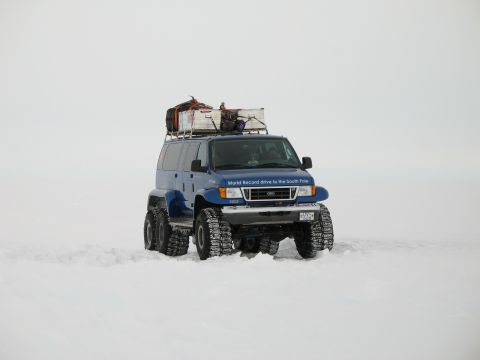
The existing US ITASE platform is currently located at the northern end of the inland portion of the Byrd Glacier drainage basin approximately 500 km along the US ITASE Phase 2 route from Taylor Dome to South Pole. As a consequence there is little expectation that US ITASE would dramatically alter its platform components. This said the US ITASE platform was first developed in the late 1990s. Since inception the US ITASE traverse platform has morphed via plan and necessity into its current state. It has traveled well over 7500 km and sustained considerable hard service. Therefore in the following we present the current configuration state of the platform, proposed minor modifications for the 2007-08 season and ideas for future platforms that could serve ITASE-like logistic and scientific needs.

During the 2006–07 the platform (Fig. 5) included one lead Pisten Bully plus two Challenger 55 teams all pulling sleds. Details of the individual components appear in the preceding report. This platform utilizes spreader bars for pulling sleds behind the Challenger 55s. The spreader bars were designed and built by Rick Schneider. The spreader bars reduced significantly the draw bar pull of each sled making travel easier. However, the 2006-07 travel conditions were amongst the flattest and hardest encountered during all US ITASE traverses. The primary flaw in the drawbar system came when traveling over regions of unusually irregular relief, notably large sastrugi. In these situations the spreader bars were spaced sleds out widely enough that the chances of one trailing sled running over relief irregular enough to cause near tip over increased. To counter this situation the Challenger 55 pulling the only passenger sleds (Blue Room and Kitchen) were re–configured to pull sleds in line (Fig. 6).Modifications needed to the existing US ITASE platform in order to continue with the 2007–08 season are relatively modest and dealt with in the preceding report.

The existing US ITASE platform could continue with annual modifications to perform as in the past. However, the equipment is old, has traveled very long distances, has inherent flaws such as overly heavy buildings, heavy sleds, and fuel intensive vehicles. Reducing future travel with this platform is advised following completion of US ITASE Phase 2. This leaves the question of what to do with the existing platform. Our suggestion is to utilize the platform under conditions of reduced travel. In particular the platform could serve as an excellent base camp for large geological field parties that operate along the headward regions of the Transantarctic Mountains. With minor modifications the existing platform could house 20-30 people and provide a base camp that could move each season to a different portion of the Transantarctic Mountains without the necessity of constructing and deconstructing temporary shelters.

Purpose: Redefining USITASE science platform in light of past experience. This option requires the use of resupply by Twin Otter and Basler.
Primary concept: Utilize more fuel efficient vehicles, avoid all heavy sleds, streamline support requirements, while maintaining current science quality. More fuel efficient vehicles might include Haaglunds, Pisten Bullys, or converterted trucks, vans.
As and example utilize “some” version of the 6x6 van driven to South Pole from Patriot Hills in 2005. The Swedes regularly use a Toyota Forerunner up to at least 2000 m on the plateau.
Prototype test at South Pole drive an existing van 100 km and back loaded with traverse comparable weight as a cheap test. Other uses: emergency rescue (69 hours, 1300 km to South Pole); servicing AGO sites.
During the in initial period of the 2006-07 field season when there was a possibility that the existing platform would not be ready ion time for the season we developed another logistics plan for undertaking US ITASE activities. This plan was based on splitting up the US ITASE science effort into two components:
This is not the preferred option because it undermines the multi-disciplinary approach that has been so successful for ITASE, but it is an option in the event that the existing platform is not available.
Based on the experiences of US ITASE and lighter weight snowmobile parties there are several new options for scientific traverse parties that can be more fuel and weight efficient than US ITASE and yet able to sustain more scientific activity than snowmobile teams. One option is the LWT described above. Others include the use of heavy duty plastic sleds carrying lightweight shelters pulled by Haaglands, modified trucks with grid tracks, etc. We suggest that OPP consider organizing a small group of potential users to suggest alternative platforms for use by oversnow scientific traverse teams.